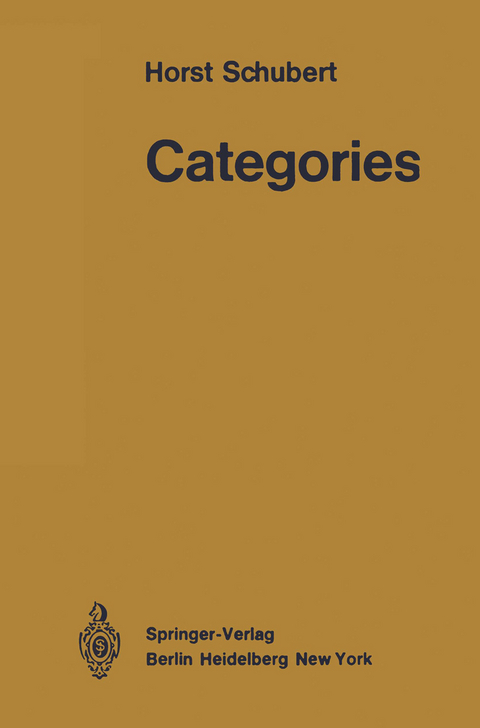
Categories
Springer Berlin (Verlag)
978-3-642-65366-7 (ISBN)
1. Categories.- 1.1 Definition of Categories.- 1.2 Examples.- 1.3 Isomorphisms.- 1.4 Further Examples.- 1.5 Additive Categories.- 1.6 Subcategories.- 1.7 Problems.- 2. Functors.- 2.1 Covariant Functors.- 2.2 Standard Examples.- 2.3 Contravariant Functors.- 2.4 Dual Categories.- 2.5 Bifunctors.- 2.6 Natural Transformations.- 2.7 Problems.- 3. Categories of Categories and Categories of Functors.- 3.1 Preliminary Remarks.- 3.2 Universes.- 3.3 Conventions.- 3.4 Functor Categories.- 3.5 The Category of Small Categories.- 3.6 Large Categories.- 3.7 The Evaluation Functor.- 3.8 The Additive Case.- 3.9 Problems.- 4. Representable Functors.- 4.1 Embeddings.- 4.2 Yoneda Lemma.- 4.3 The Additive Case.- 4.4 Representable Functors.- 4.5 Partially Representable Bifunctors.- 4.6 Problems.- 5. Some Special Objects and Morphisms.- 5.1 Monomorphisms.- 5.1° Epimorphisms.- 5.2 Retractions and Coretractions.- 5.3 Bimprphisms.- 5.4 Terminal and Initial Objects.- 5.5 Zero objects.- 5.6 Problems.- 6. Diagrams.- 6.1 Diagram Schemes and Diagrams.- 6.2 Diagrams with Commutativity Conditions.- 6.3 Diagrams as Presentations of Functors.- 6.4 Quotients of Categories.- 6.5 Classes of Mono-, resp., Epimorphisms.- 6.6 Problems.- 7 Limits.- 7.1 Definition of Limits.- 7.2 Equalizers.- 7.3 Products.- 7.4 Complete Categories.- 7.5 Limits in Functor Categories.- 7.6 Double Limits.- 7.7 Criteria for Limits.- 7.8 Pullbacks.- 7.9 Problems.- 8. Colimits.- 8.1 Definition of Colimits.- 8.2 Coequalizers.- 8.3 Coproducts.- 8.4 Cocomplete Categories.- 8.5 Colimits in Functor Categories.- 8.6 Double Colimits.- 8.7 Criteria for Colimits.- 8.8 Pushouts.- 8.9 Problems.- 9. Filtered Colimits.- 9.1 Connected Categories.- 9.2 On the Calculation of Limits and Colimits.- 9.3 Filtered Categories.- 9.4 Filtered Colimits.- 9.5Commutativity Theorems.- 9.6 Problems.- 10. Setvalued Functors.- 10.2 Properties Inherited from the Codomain Category.- 10.2 The Yoneda Embedding H*: C ? [C0, Ens].- 10.3 The General Representation Theorem.- 10.4 Projective and Injective Objects.- 10.5 Generators and Cogenerators.- 10.6 Well-powered Categories.- 10.7 Problems.- 11. Objects with an Algebraic Structure.- 11.1 Algebraic Structures.- 11.2 Operations of an Object on Another.- 11.3 Homomorphisms.- 11.4 Reduction to Ens.- 11.5 Limits and Filtered Colimits.- 11.6 Homomorphically Compatible Structures.- 11.7 Problems.- 12. Abelian Categories.- 12.1 Survey.- 12.2 Semi-additive Structure.- 12.3 Kernels and Cokernels.- 12.4 Factorization of Morphisms.- 12.5 The Additive Structure.- 12.6 Idempotents.- 12.7 Problems.- 13. Exact Sequences.- 13.1 Exact Sequences in Exact Categories.- 13.2 Short Exact Sequences.- 13.3 Exact and Faithful Functors.- 13.4 Exact Squares.- 13.5 Some Diagram Lemmas.- 13.6 Problems.- 14. Colimits of Monomorphisms.- 14.1 Preordered Classes.- 14.2 Unions of Monomorphisms.- 14.3 Inverse Images of Monomorphisms.- 14.4 Images of Monomorphisms.- 14.5 Constructions for Colimits.- 14.6 Grothendieck Categories.- 14.7 Problems.- 15. Injective Envelopes.- 15.1 Modules over Additive Categories.- 15.2 Essential Extensions.- 15.3 Existence of Injectives.- 15.4 An Embedding Theorem.- 15.5 Problems.- 16. Adjoint Functors.- 16.1 Composition of Functors and Natural Transformations.- 16.2 Equivalences of Categories.- 16.3 Skeletons.- 16.4 Adjoint Functors.- 16.5 Quasi-inverse Adjunction Transformations.- 16.6 Fully Faithful Adjoints.- 16.7 Tensor Products.- 16.8 Problems.- 17. Pairs of Adjoint Functors between Functor Categories.- 17.1 The Kan Construction.- 17.2 Dense Functors.- 17.3 Characterization of theYoneda Embedding.- 17.4 Small Projective Objects.- 17.5 Finitely Generated Objects.- 17.6 Natural Transformations with Parameters.- 17.7 Tensor Products over Small Categories.- 17.8 Relatives of the Tensor Product.- 17.9 Problems.- 18. Principles of Universal Algebra.- 18.1 Algebraic Theories.- 18.2 Yoneda Embedding and Free Algebras.- 18.3 Subalgebras and Cocompleteness.- 18.4 Coequalizers and Kernel Pairs.- 18.5 Algebraic Functors and Left Adjoints.- 18.6 Semantics and Structure.- 18.7 The Kronecker Product.- 18.8 Characterization of Algebraic Categories.- 18.9 Problems.- 19. Calculus of Fractions.- 19.1 Categories of Fractions.- 19.2 Calculus of Left Fractions.- 19.3 Factorization of Functors and Saturation.- 19.4 Interrelation with Subcategories.- 19.5 Additivity and Exactness.- 19.6 Localization in Abelian Categories.- 19.7 Characterization of Grothendieck Categories with a Generator.- 19.8 Problems.- 20. Grothendieck Topologies.- 20.1 Sieves and Topologies.- 20.2 Covering Morphisms and Sheaves.- 20.3 Sheaves Associated with a Presheaf.- 20.4 Generation of Topologies.- 20.5 Pretopologies.- 20.6 Characterization of Topos.- 20.7 Problems.- 21. Triples.- 21.1 The Construction of Eilenberg and Moore.- 21.2 Full Image and Kleisli Categories.- 21.3 Limits and Colimits in Eilenberg-Moore Categories.- 21.4 Split Forks.- 21.5 Characterization of Eilenberg-Moore Situations.- 21.6 Consequences of Factorizations of Morphisms.- 21.7 Eilenberg-Moore Categories as Functor Categories.- 21.8 Problems.
| Erscheint lt. Verlag | 11.11.2011 |
|---|---|
| Übersetzer | Eva Gray |
| Zusatzinfo | XIII, 385 p. |
| Verlagsort | Berlin |
| Sprache | englisch |
| Maße | 155 x 235 mm |
| Gewicht | 609 g |
| Themenwelt | Mathematik / Informatik ► Mathematik ► Algebra |
| Schlagworte | Adjoint functor • Algebra • categories • category theory • colimit • Coproduct • Development • Equalizer • Homomorphism • Initial object • Kategorie • Kategorie (Math.) • Microsoft Access • SET • Transformation • zero object |
| ISBN-10 | 3-642-65366-9 / 3642653669 |
| ISBN-13 | 978-3-642-65366-7 / 9783642653667 |
| Zustand | Neuware |
| Informationen gemäß Produktsicherheitsverordnung (GPSR) | |
| Haben Sie eine Frage zum Produkt? |
aus dem Bereich


